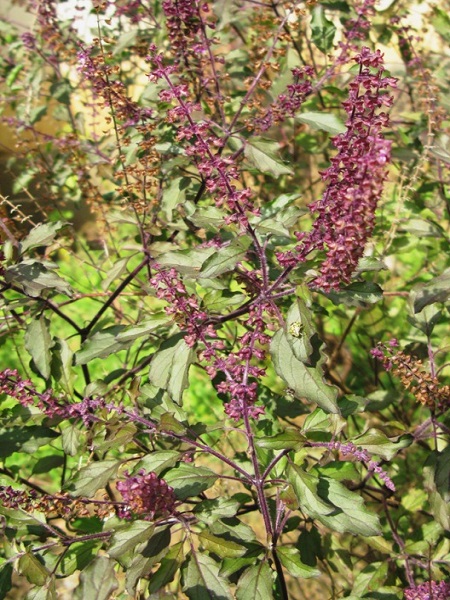
| Family | Lamiaceae |
| English Name | Tulsi |
| Malayalam Name | Krishnahulasi, thulasi |
| Tamil Name | Alangai, ari, ceccai |
| Kannada Name | Sritulasi, tulashi |
| Telugu Name | Gaggera-chettu |
| Hindi Name | Baranda, kalatulas |
| Sanskrit Name | Ajaka, amrita, apetaraksasi |
| Trade Name | Tulsi |
| Part Used | Leaves, flowers, root, and stem |
| In Wild | Yes |
| Under Cultivation | Yes |
| Temperature | 25 C to 35 0 C |
| Rainfall | 80- 120 cm |
| Farmers | NA |
| Traders | NA |
| Institution | NA |
| Individually | NA |
| State/Region | NA |
| District | NA |
| Nursery Information | NA |
| Yield | NA |
| Economic of cultivation | Rs. 18,106/- is the estimated cost of cultivation for one hectare. • Market price as on May 2018 is Rs. 100- 300/kg |
| Quantitative quality standards | Foreign matter: not more than 2% Ash: not more than 17.7% Acid insoluble ash: not more than 2.8% Ethanol soluble extraction: not less than 8% Water soluble extraction: not less than 19% |
| Description | NA |
| Agro technology/Cultivation practices | Planting-stock production: Propagules could be raised from seeds and terminal cuttings. Seed propagation: The crop can be propagated through seeds. For propagating through seeds, they are to be sown in the nursery beds. For sowing of one hectare about 300g of seeds are required. The nursery should be located preferably in partial shade with adequate irrigation facilities. Soil is worked upto a depth of about 30 cm. well rotten farm yard manure is applied to the soil and prepared to a fine tilth and seed beds of 4.5x1.0x0.2 m size are prepared. As the seeds are minute, the required quantity of seeds are mixed with sand in the ratio of 1:4 and sown in nursery bed, 2 months in advance of the onset of monsoon. They germinate in 8-12 days and seedlings are ready for transplanting in about 6 weeks’ time at 4-5 leaf stage. Vegetative propagation: Tulsi can also be propagated by vegetative method using terminal cuttings with about 90-100 per cent success when planted during October-December months. Field planting: Six weeks old Seedlings with 4-5 leaves are transplanted at a spacing of 40 × 40 cm, 40 × 50 cm and 50 × 30 cm to get high herbage and oil yield Manuring/Fertilization: The plant requires about 15t/ha of FYM which is to be applied as basal dose at the time of land preparation. Irrigation: Irrigation is provided twice a week till one month so that the plants establish themselves well. Later, it is given at weekly interval depending upon the rainfall and soil moisture status. Pests and disease: Tulsi is not prone to serious pest/disease except some minor pests like leaf rollers which can be controlled by spraying with 0.2% Malathion or 0.1% Methyl parathion whenever noticed. Diseases like powdery mildew can be controlled by spraying with 0.3% wettablesulphur. Likewise seedling blight and root rot can be controlled by drenching the nursery beds with a 0.1 per cent solution of mercurial fungicide and adopting phytosanitory measures. |
| Harversting | The first harvest is done after 90 days of planting and subsequently it may be harvested at every 75 days interval. The crop is harvested at full bloom stage by cutting the plants at 15 cm from ground level to ensure good regeneration for further harvests. The yield and oil content is more in plants harvested during sunny days. |
| Processing | NA |
| References | NA |
